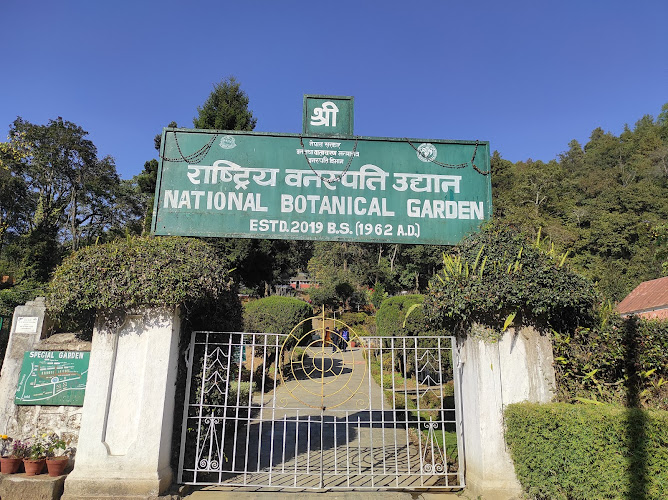

National botanical gardens - Living Plant Museum & Orchid Conservation Center
Satdobato-Godavari Rd, Godawari 44709
Fifteen kilometers south of Kathmandu in Godavari village, where the Kathmandu Valley rises toward the forested slopes of Phulchowki Hill, Nepal's National Botanical Garden spreads across terraces first designed by British botanists G.A.C. Herklots and Tony Schilling in 1962. Unlike national parks protecting wilderness, this 82-hectare garden represents cultivated nature—a living collection of 4,500 flowering and non-flowering plant specimens arranged in thematic gardens, conservatories, and research plots that function simultaneously as conservation gene bank, scientific research facility, educational resource, and public park where Kathmandu families picnic beneath rare trees while botanists catalog orchids in climate-controlled greenhouses.
The Orchid House stands among the garden's premier attractions, its climate-controlled interior sheltering Nepal's native orchid species alongside cultivated varieties from across the Himalayas. Delicate blooms in impossible colors—striped purple and white, spotted yellow and crimson, pure white with contrasting lips—demonstrate the orchid family's extraordinary adaptive radiation. During blooming seasons, photographers and orchid enthusiasts crowd the greenhouse, documenting species rarely seen in the wild and varieties developed through decades of careful hybridization. The collection serves scientific purposes beyond aesthetics, preserving genetic diversity of species threatened by habitat loss and climate change while supporting research into orchid ecology, pollination biology, and conservation propagation.
Beyond orchids, specialized gardens showcase roses, ferns, cacti and succulents, aquatic plants, medicinal herbs, and native flora arranged by ecosystem. The rock garden features alpine species from high Himalayan zones, their cushion growth forms and brilliant flowers evolved for harsh conditions recreated through careful soil preparation and microclimate management. The medicinal plant collection preserves species used in Ayurvedic and Tibetan medicine, documenting traditional knowledge before it vanishes with elder practitioners. Native forest plots demonstrate Kathmandu Valley's original vegetation before agriculture transformed the landscape, offering glimpses of ecosystems now reduced to fragments.
Research facilities including herbarium and library support botanical studies and plant taxonomy. Scientists collaborate with international institutions on plant conservation, ecology, and climate change impacts. Educational programs bring schoolchildren to learn plant identification, ecology, and conservation importance. University students conduct thesis research on plant systematics, reproductive biology, and cultivation techniques. The garden's dual function—public recreation space and scientific research facility—creates synergies where visitor fees help fund research while scientific collections enhance visitor experiences.
The garden's location on Phulchowki Hill's lower slopes positions it within one of Nepal's biodiversity hotspots. Phulchowki's forests harbor over 300 bird species and countless plants, making the area critical for both in-situ conservation (protecting wild ecosystems) and ex-situ conservation (maintaining cultivated collections as insurance against extinction). The botanical garden's collections complement wildland protection, preserving species and genetic diversity that can be reintroduced if wild populations crash.
Seasonal changes transform the garden's character. Spring brings rhododendron blooms in shades from white to crimson, cherry blossoms, and the garden's signature magnolias. Summer monsoons drench the landscape in green, aquatic gardens flourishing while tropical species thrive in heat and humidity. Autumn delivers clear skies and comfortable temperatures ideal for visiting, while winter strips deciduous trees bare and slows growth but allows greenhouse collections to shine as tropical orchids and cacti continue blooming regardless of outside cold.
Visitor facilities include walking paths, rest areas, and modest amenities though infrastructure lags behind demand. Weekend crowds can overwhelm capacity, particularly during peak seasons when families escape Kathmandu's pollution and heat. Entrance fees remain nominal (local visitors pay 40 rupees, foreigners 150 rupees), barely covering maintenance costs and leaving conservation and research programs dependent on government allocations and donor support.
The garden faces challenges from inadequate funding, aging infrastructure, climate change impacts requiring costly greenhouse climate control, and competition with private botanical gardens and commercial nurseries. Yet it endures as Nepal's premier plant conservation facility, a 63-year-old institution that has weathered earthquakes, political upheavals, and funding crises through dedication of staff who maintain collections even when budgets disappear. For botanists studying Himalayan flora, the National Botanical Garden represents an irreplaceable resource. For families seeking weekend respite from urban chaos, it offers peaceful gardens and shaded picnic spots. For students learning plant science, it provides living laboratories where textbook concepts manifest in leaves, flowers, and roots. And for conservationists fighting species extinctions, it offers hope that even when wild habitats vanish, carefully curated collections preserve genetic diversity and knowledge essential for restoration when—or if—conditions allow nature's return.
Park Features & Amenities
🛠️ Service options
- ✓ On-site services
♿ Accessibility
- ✓ Wheelchair-accessible car park
- ✓ Wheelchair-accessible entrance
🏃 Activities
- ✓ Hiking
🏗️ Amenities
- ✓ Picnic tables
- ✓ Public toilet
🎠 Children
- ✓ Good for kids
- ✓ Good for kids birthday
- ✓ Kid-friendly hikes
Visitor Information
🕐 Best Times to Visit
Spring (Mar-May): Pleasant weather, blooming flowers
Autumn (Sep-Nov): Clear skies, comfortable temperatures
Early Morning: Best for wildlife viewing and photography
🗺️ Getting There
By Car: Satdobato-Godavari Rd, Godawari 44709
Public Transport: Local buses and taxis available
Walking: Check distance from city center
💡 Visitor Tips
• Bring water and sun protection
• Wear comfortable walking shoes
• Check weather conditions before visiting
• Bring camera for nature photography
Explore More in Nepal
Nearby Attractions
Popular Activities
Ready to Visit National botanical gardens?
Plan your visit to this amazing destination with our comprehensive travel guide and insider tips.
Seasonal Travel Guide
Weather & Best Time
Winter brings cool temperatures (5-15°C) with clear skies and snow-capped peaks. Perfect for mountain views but cold at higher altitudes.
Best Activities:
- Mountain viewing
- Cultural experiences
- Spa and hot springs
- Photography of snow peaks
- Indoor cultural activities
Travel Tips
- Visit during December-February for snow-capped views
- Pack warm clothing for cold temperatures
- Book hotels with heating facilities
- Plan for shorter daylight hours
Packing Suggestions:
- Warm winter clothing
- Thermal layers
- Warm hat and gloves
- Sturdy winter boots
- Hot water bottle
Quick Facts
Best time: Autumn (Sep-Nov)
Duration: 1-3 days
Difficulty: Easy
Cost: Budget-friendly